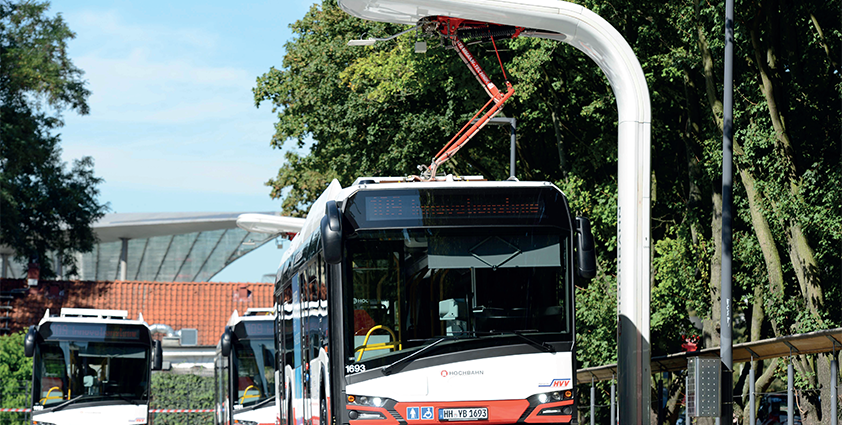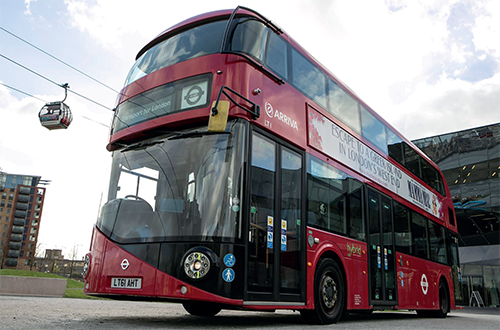
It’s electric
Road transport, which includes buses, is a significant contributor to air pollution, resulting in poor air quality. Public Health England (PHE) says air pollution is the biggest environmental threat to health with between 28,000 and 36,000 deaths a year attributed to long-term exposure.
Concerns surrounding climate change and air pollution have long prompted the passenger transport industry to transition towards a low carbon future. The Confederation of Passenger Transport (CPT), an organization that represents more than 95 per cent of the UK’s bus industry, had already pledged to only invest in low-emission vehicles from 2025.
Developing sustainable clean transport in the UK has been a complex undertaking and has required the integration of new technologies and solutions into existing infrastructures. And while much has been learned about (electric bus) installations so far, charging practicalities, grid demands and funding difficulties continue to throw up challenges for the industry.
Charging practicalities
The predictability of schedules and recharging times has made overnight plug-in charging (depot charging) the preferred method for re-energizing electric buses (e-buses) here. Slower low-power AC charging is commonplace but where vehicles are needed back on the road in two to three hours, high-power DC charging has provided a faster turnaround. On longer city routes, fast-charging high-power choices such as pantographs have been applied, although this has mainly happened across the US and Europe. These systems take some of the charging burden away from the depot by using a retractable apparatus, mounted on top of a bus, to ‘flash’ charge whenever there is a stop for an extended period. While there seems to be limitless possibilities to charging, technological and economic factors are determining how power is managed efficiently.
The complexities surrounding the infrastructure required to deliver the electrical energy for charging the vehicles can sometimes be underestimated – it’s rarely a simple case of installing multiple chargers at the depot. Considerable thought should be given to how the various pieces of the charging system are constructed and integrated to ensure seamless and efficient fleet operation. These components typically consist of the electrical power grid connection, power distribution infrastructure, charging points and software management systems, service agreements and the vehicles. Charging technology OEMs in collaboration with vehicle OEMs are often best placed to take the lead once a need has been established.
Grid demands
While some installations can be straightforward, others end up being more complicated. Much is dependent on the location of the site and its access to the grid which affects the kind of infrastructure that can be delivered. Reliable and resilient power with 100 per cent uptime is a given but sites may require power distribution systems in the depot to be upgraded or consultations with Distribution Network Operators to increase the capacity on the power grid external to the depot.
Supplying an electric fleet of buses with energy creates significant pressures, particularly during periods of high demand. Solutions and smart charging management software can shift charging loads to specific times and energy storage systems and off-grid green energy options can compensate for the rise and fall of demand. Siemens has already delivered many projects that are showcasing the potential of different vehicle technologies and charging systems. These projects are providing important insights into the electrification of the transport sector and modern energy systems. However, most operators are only concentrating on the business of ‘getting us from A-B’ in a timely manner and delivering cleaner greener journeys.
Finance
The move to an electric future offers many benefits but has required substantial financial investments. Even with the cost of batteries and chargers gradually falling alongside technological advancements, the upfront costs for the vehicles can be a challenge. However, energy and maintenance costs will be lower in comparison with equivalents. While this disparity is reversed after acquisition, the financial barriers go beyond acquiring a new bus fleet. At present only 1,600 technicians nationwide are qualified in electric vehicle and hybrid maintenance, and they are almost exclusively employed within manufacturers’ franchised dealer networks which has a knock-on effect for the cost and convenience of repairs1.
The difficulties associated with investing in charging infrastructure have also seen a surge in innovative financial collaborations between energy companies, operators, manufacturers, and cities and councils to help minimize risks and spread costs along the supply chain. Working with public and private fleet managers to build depots – capable of delivering megawatts of energy that are scalable and financed with no upfront capital outlay – requires specialist financing and knowledge.
Travelling in the right direction
There have been calls for more help. Darren Shirley, Chief Executive of the Campaign for Better Transport said: “The Government should put in place deadlines for all new buses to be electric or hydrogen-powered by 2025, and all buses on the road to be zero-emission by 2035. This means we need to rapidly deploy zero emission technology and tackle any barriers to uptake. This can be supported through the Government introducing a ‘fleet and depot transition fund’ to get infrastructure in place, and a ‘bus manufacturing fund’ to help the UK bus industry scale up to build more zero-emission buses. With this support in place, all bus operators can and must make cleaning up their fleets a priority2.”
The electric bus revolution continues to travel in the right direction. The government’s new bus strategy, backed by £3 billion of investment, will make buses across the country cheaper and easier to use. Hundreds of miles of new bus lanes and price caps on tickets are being planned as part of ambitious reforms within the sector. The ten-point plan will deliver 4,000 new British-built zero emission buses to accelerate the transition to greener and more sustainable transport. Consultation will also begin to decide the date to end the sale of diesel buses. The plan will mark a new era for buses.
And working with the right partner is a prerequisite. There are only a handful of world-class vendors proficient at the planning, implementation and operation of eMobility charging infrastructure strategies. Extensive power and grid technical knowledge have to be balanced with the experience of delivering reliable scalable high-performance solutions on time with limited disruptions.
We have travelled far but there is still an enormous amount of work to do. It will need the coordination of multiple agencies, Government policies, industry bodies, energy and transport planning, technologists, operators and financiers. But once all the correct infrastructure is in place then the prize on offer is a sustainable clean transport future.
1 https://publications.parliament.uk/pa/cm201719/cmselect/cmbeis/383/38309.htm
2 ‘Electric vxehicles: driving the transition’, House of Commons Business, Energy and Industrial Strategy Committee, 19 October 2018. https://publications.parliament.uk/pa/cm201719/cmselect/cmbeis/383/383.pdf
 Bernard Magee is Managing Director – eMobility, Siemens GB&I. Siemens AG (Berlin and Munich) is a global technology powerhouse that has stood for engineering excellence, innovation, quality, reliability and internationality for more than 170 years. Active around the world, the company focuses on intelligent infrastructure for buildings and distributed energy systems and on automation and digitalization in the process and manufacturing industries. Siemens brings together the digital and physical worlds to benefit customers and society. Through Mobility, a leading supplier of intelligent mobility solutions for rail and road transport, Siemens is helping to shape the world market for passenger and freight services. Campaign for Better Transport operates in England and Wales. It campaigns to bring sustainable transport to all and ensures solutions are delivered that improve the wellbeing of communities, quality of life and the environment. Campaign for Better Transport Charitable Trust is a registered charity (1101929).
Bernard Magee is Managing Director – eMobility, Siemens GB&I. Siemens AG (Berlin and Munich) is a global technology powerhouse that has stood for engineering excellence, innovation, quality, reliability and internationality for more than 170 years. Active around the world, the company focuses on intelligent infrastructure for buildings and distributed energy systems and on automation and digitalization in the process and manufacturing industries. Siemens brings together the digital and physical worlds to benefit customers and society. Through Mobility, a leading supplier of intelligent mobility solutions for rail and road transport, Siemens is helping to shape the world market for passenger and freight services. Campaign for Better Transport operates in England and Wales. It campaigns to bring sustainable transport to all and ensures solutions are delivered that improve the wellbeing of communities, quality of life and the environment. Campaign for Better Transport Charitable Trust is a registered charity (1101929).
www.siemens.com
www.siemens.com/smart-infrastructure
www.siemens.com/ebus